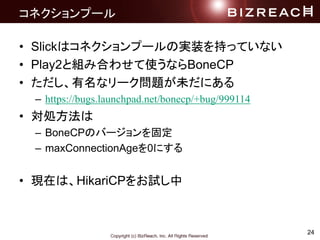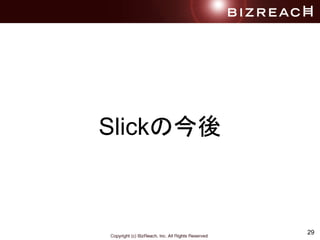厂濒颈肠办入门
- 2. 2 アジェンダ ? Scalaの代表的なORM ? Slickの基本的なお話 – スキーマ定義 – クエリ ? SQLを直接書く方法 – Plain SQL – その他の選択肢 ? Play2 + Slickで使うには – 設定 – コネクションまわり ? プロジェクトでの留意点
- 3. 3 Scalaで使えるORM ? Slick(旧ScalaQuery) – タイプセーフなDSLや、SQLも記述可能 – 極力Scalaのコレクションと同じように扱えるよう設計され ている ? Squeryl – SQLは使用せず、DSLでクエリを記述する – コンセプトは、できるだけシンプルに val query = from(table) (t => where(t.id === id) select(t))
- 4. 4 Scalaで使えるORM ? Anorm – SQLを直接書くスタイル – 手動でORマッピングを行う ? Scala ActiveRecord – Squerylをベースに、モデル定義やよく使う機能をRailsの ActiveRecordに似せている(CoC、DRY) SQL("select * from User") .as( int("id") ~ str("name") map { case id~name => Person(id, name) } *)
- 6. 6 Slickのきほん
- 7. 7 タイプセーフなクエリ ? Slickは以下のように、クエリをタイプセーフに記述で きることが1つの特徴 ? このクエリを書くためには、スキーマ定義が必要 val id = 1L val user: Option[UsersRow] = Users.filter(_.id is id.bind).firstOption select * from USERS x1 where x1.ID = ? SQLのイメージ
- 8. 8 スキーマ定義 ? でも、手動で書くのは面倒ですよね // マッピングするケースクラス case class UserRow(id: Long, name: String) // テーブルのスキーマ定義 class User(tag: Tag) extends Table[UserRow](tag, "USER") { def * = (id, name) <> (UserRow.tupled, UserRow.unapply) val id: Column[Long] = column[Long]("ID", O.PrimaryKey) val name: Column[String] = column[String]("NAME") } // クエリに使用 lazy val User = new TableQuery(tag => new User(tag))
- 10. 10 コードジェネレータ ? sbtのタスクとして実行 ? 生成するファイル – Tables.scala ? 生成されるもの – テーブル定義 – マッピングするケースクラス – TableQuery ? クエリで使用 – 全テーブルのDDL – GetResult(ResultSetからケースクラスに変換) ? Plain SQLで使用
- 11. 11 コードジェネレータ ? ジェネレータはカスタマイズ可能 – SourceCodeGeneratorを拡張する形 – ドキュメントがないので拡張ポイントがわかりにくい – slick.model.codegenパッケージ配下を見るとよい ? BizReachではカスタマイズして使っている – 基本的なCRUD機能 – シールドクラスとカラムのマッピング – 楽観的排他による更新機能
- 12. 12 これでクエリが書けます
- 13. 13 基本的なCRUD // 全件取得 val users: Seq[UserRow] = User.list // 登録 val res: Int = User insert UserRow(1, "なまえ") // 更新 val res: Int = User.filter(_.id is id.bind).update( UserRow(1, "なまえ変更")) // 削除 val res: Int = User.filter(_.id is id.bind).delete
- 14. 14 基本的なCRUD // 全件取得 val users: Seq[UserRow] = User.list // 登録 val res: Int = User insert UserRow(1, "なまえ") // 更新 val res: Int = User.filter(_.id is id.bind).update( UserRow(1, "なまえ変更")) // 削除 val res: Int = User.filter(_.id is id.bind).delete bindを呼ぶと バインド変数になる
- 15. 15 バインド変数になるbind ? bindなし ? bindあり val name = "ta'kako" User.filter(_.name is name).firstOption ??? from USER x1 where x1.NAME = 'ta''kako' SQLのイメージ User.filter(_.name is name.bind).firstOption ??? from USER x1 where x1.NAME = ? SQLのイメージ
- 16. 16 ケースクラスにマッピング ? <>を使えば、mapで絞り込んだ項目を別のケースク ラスにマッピングできる // このケースクラスにマッピング case class Test(id: Long, name: String) val res: List[Test] = User.map { t => t.id -> t.name <> (Test.tupled, Test.unapply) }.list
- 17. 17 他にもいろいろ ? ソート、グルーピング、ページング など ? 内部結合、外部結合も可能 ? slick-referenceをGitHubに公開中 https://github.com/bizreach/slick-reference
- 19. 19 Plain SQL ? SQLを文字列リテラルで書く ? 局所的に使うには便利 ? ただ、複雑なSQLの代替として使うには厳しい – リファクタリングがやりにくい – 動的なSQLを組み立てるためには文字列処理が必要 sql"""SELECT ID + 1 FROM ISSUE_ID WHERE USER_NAME = $owner FOR UPDATE """.as[Int].firstOption
- 20. 20 その他の選択肢 ? mirage-scala – Seasar2の2WaySQLの機能を単独のライブラリとして利 用できるようにしたもの – Slickと組み合わせて使用することも可能 val books: List[Book] = sqlManager.getResultList[Book]( Sql(""" SELECT BOOK_ID, BOOK_NAME, AUTHOR, PRICE FROM BOOK /*IF author!=null*/ WHERE AUTHOR = /*author*/'test' /*END*/ """), Map("author"->"Takako Shimamoto")) パラメータはMapではなくケース クラスで与えることも可能 条件分岐やパラメータをSQLのコメント で記述するのでコピペしてそのままDB に流して動作確認できる 外部ファイル化することも可能
- 22. 22 play-slick ? Play2でSlickを使う上で、面倒なことをいろいろやっ てくれるプラグイン – Play2の設定から自動的にSlickの Database.forDataSourceを呼び出してくれる – Slickのセッション管理を自動的にやってくれる ? withSessionやwithTransactionを呼び出してくれる – Play2のリクエストとSlickのセッションの両方を持ち合わ せたDBSessionRequestが使える SlickがPlay2に組み込まれるのと同時に このプラグインも統合される予定
- 23. 23 何が変わるの? ? コントローラでPlay2のActionの代わりに、play-slick のDBActionを使う ? トランザクションを開始する場合は DBAction.transactionを使う def list = DBAction { implicit rs => // IDの昇順にすべてのユーザ情報を取得 val users = Users.sortBy(t => t.id).list // 一覧画面を表示 Ok(views.html.user.list(users)) }
- 24. 24 コネクションプール ? Slickはコネクションプールの実装を持っていない ? Play2と組み合わせて使うならBoneCP ? ただし、有名なリーク問題が未だにある – https://bugs.launchpad.net/bonecp/+bug/999114 ? 対処方法は – BoneCPのバージョンを固定 – maxConnectionAgeを0にする ? 現在は、HikariCPをお試し中
- 26. 26 留意事項 ? アグレッシブな機能追加/削除 – Scala全体の傾向(Slickも例外ではない) – 特にメジャーアップにはマイグレーションが必要 – 常にキャッチアップして対応していく必要がある ? マニュアルがあまり豊富でない – 本家サイトには書いてないが、できることが色々ある – 慣れるまでに多少の時間が必要 – 充実させようとしている動きはある – BizReachで公開しているリファレンスをぜひ活用を
- 27. 27 留意事項 ? 結合は発行されるSQLに注意 – 単一テーブルなら、①fiterで絞り込む、②mapで取得項目 を決める、③listやfirstOptionで実行、という流れ – 結合は、メソッドチェーンとfor式で発行するSQLが異なる // select ??? from (select * from A) s1 inner join (select * from B) s2 on ??? A.innerJoin(B).on(???) // select ??? from A s1, B s2 where (s1.column = s2.column) and ?? for { t1 <- A t2 <- B if ??? } yield ???
- 28. 28 留意事項 ? Play2のEvolutionsは実践には厳しい – 1.sql、2.sql???の管理はプログラマがやる – ミスした場合、エボリューション用のテーブルを元に戻すと いう操作を手動でやらないといけない – ある程度の規模になるとメンテが困難
- 29. 29 Slickの今後
- 30. 30 次期バージョン2.1 ? 使いやすさの向上 – APIの改善 – ドキュメントの充実 ? Play2.4からデフォルトのO/Rマッパ(予定) ? Direct Embedding – ケースクラスにアノテーションを付与 ? スキーマ定義が不要になる – 暗黙の型変換の代わりに、マクロを使用 ? 実装するコード量が減る – 現在は実験的な機能として提供 ? 今後に期待
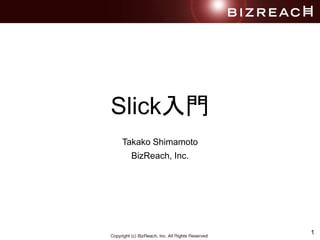
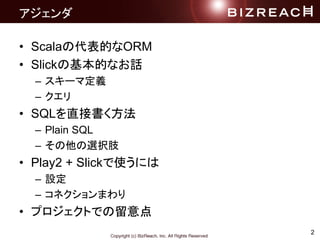
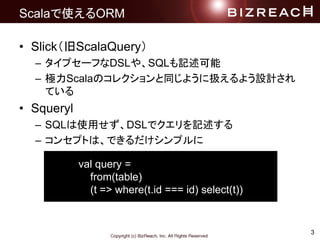



![7
タイプセーフなクエリ
? Slickは以下のように、クエリをタイプセーフに記述で
きることが1つの特徴
? このクエリを書くためには、スキーマ定義が必要
val id = 1L
val user: Option[UsersRow] =
Users.filter(_.id is id.bind).firstOption
select * from USERS x1 where x1.ID = ?
SQLのイメージ](https://image.slidesharecdn.com/slick-140603074510-phpapp02/85/Slick-7-320.jpg)
 {
def * = (id, name) <> (UserRow.tupled, UserRow.unapply)
val id: Column[Long] = column[Long]("ID", O.PrimaryKey)
val name: Column[String] = column[String]("NAME")
}
// クエリに使用
lazy val User = new TableQuery(tag => new User(tag))](https://image.slidesharecdn.com/slick-140603074510-phpapp02/85/Slick-8-320.jpg)
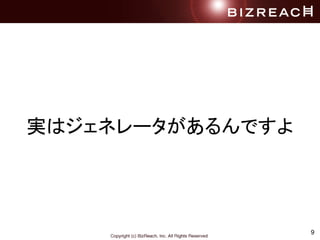


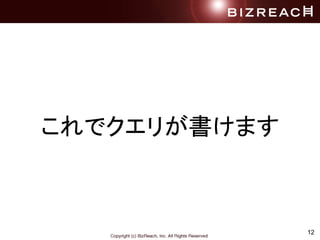
![13
基本的なCRUD
// 全件取得
val users: Seq[UserRow] = User.list
// 登録
val res: Int = User insert UserRow(1, "なまえ")
// 更新
val res: Int = User.filter(_.id is id.bind).update(
UserRow(1, "なまえ変更"))
// 削除
val res: Int = User.filter(_.id is id.bind).delete](https://image.slidesharecdn.com/slick-140603074510-phpapp02/85/Slick-13-320.jpg)
![14
基本的なCRUD
// 全件取得
val users: Seq[UserRow] = User.list
// 登録
val res: Int = User insert UserRow(1, "なまえ")
// 更新
val res: Int = User.filter(_.id is id.bind).update(
UserRow(1, "なまえ変更"))
// 削除
val res: Int = User.filter(_.id is id.bind).delete
bindを呼ぶと
バインド変数になる](https://image.slidesharecdn.com/slick-140603074510-phpapp02/85/Slick-14-320.jpg)
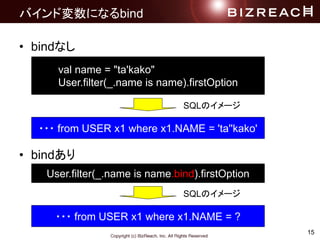
![16
ケースクラスにマッピング
? <>を使えば、mapで絞り込んだ項目を別のケースク
ラスにマッピングできる
// このケースクラスにマッピング
case class Test(id: Long, name: String)
val res: List[Test] = User.map { t =>
t.id -> t.name <> (Test.tupled, Test.unapply)
}.list](https://image.slidesharecdn.com/slick-140603074510-phpapp02/85/Slick-16-320.jpg)

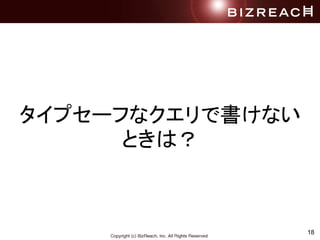
![19
Plain SQL
? SQLを文字列リテラルで書く
? 局所的に使うには便利
? ただ、複雑なSQLの代替として使うには厳しい
– リファクタリングがやりにくい
– 動的なSQLを組み立てるためには文字列処理が必要
sql"""SELECT ID + 1
FROM ISSUE_ID
WHERE USER_NAME = $owner FOR UPDATE
""".as[Int].firstOption](https://image.slidesharecdn.com/slick-140603074510-phpapp02/85/Slick-19-320.jpg)
![20
その他の選択肢
? mirage-scala
– Seasar2の2WaySQLの機能を単独のライブラリとして利
用できるようにしたもの
– Slickと組み合わせて使用することも可能
val books: List[Book] = sqlManager.getResultList[Book](
Sql("""
SELECT BOOK_ID, BOOK_NAME, AUTHOR, PRICE
FROM BOOK
/*IF author!=null*/
WHERE AUTHOR = /*author*/'test'
/*END*/
"""), Map("author"->"Takako Shimamoto"))
パラメータはMapではなくケース
クラスで与えることも可能
条件分岐やパラメータをSQLのコメント
で記述するのでコピペしてそのままDB
に流して動作確認できる
外部ファイル化することも可能](https://image.slidesharecdn.com/slick-140603074510-phpapp02/85/Slick-20-320.jpg)



